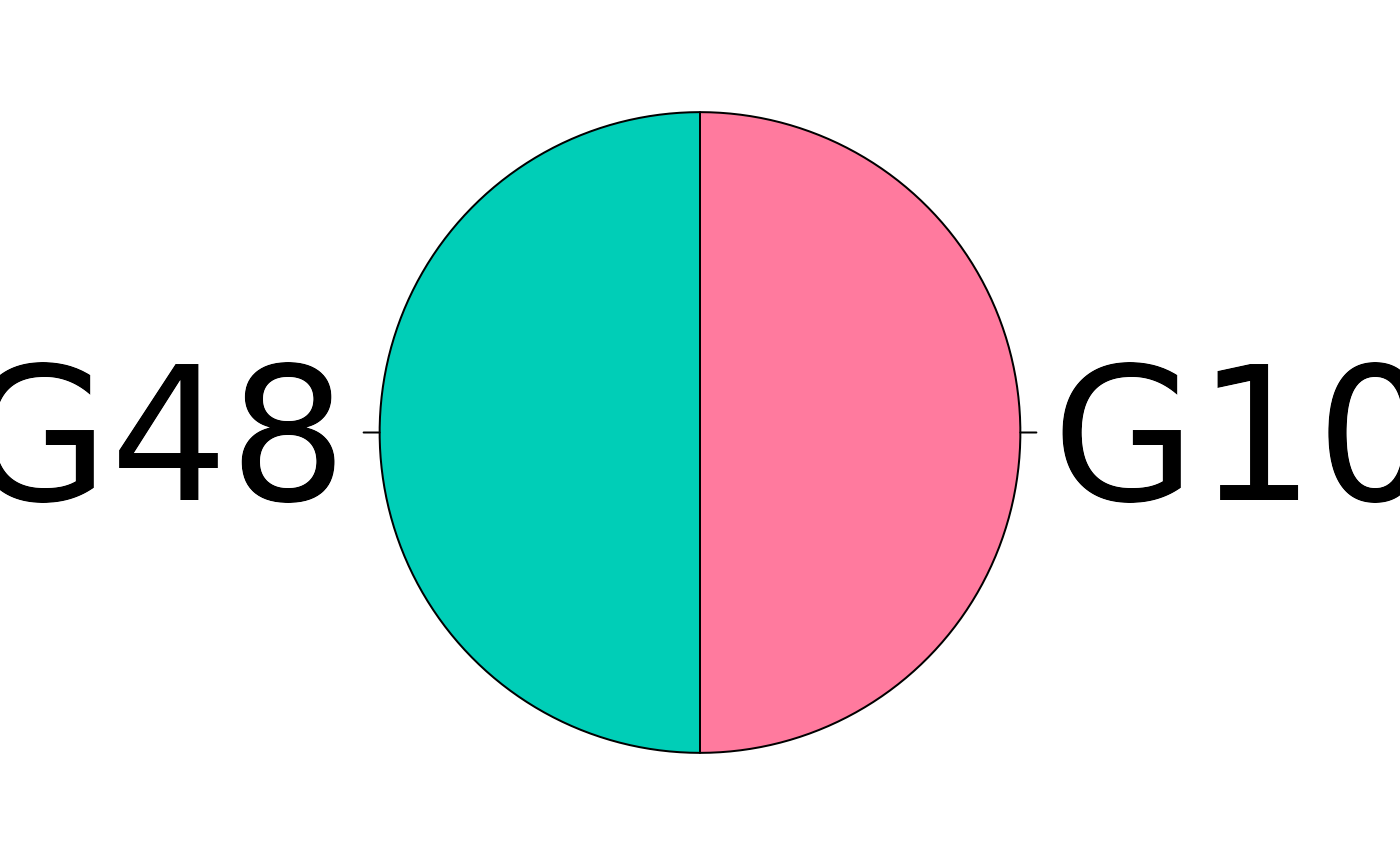Gene Set Enrichment Analysis
Robert M Flight
2025-09-08 19:32:28.600068
Source:vignettes/gsea.Rmd
gsea.RmdIntroduction
categoryCompare2 was originally designed to work with
enrichments generated via hypergeometric enrichment, or
over-representation. However, there are some limitations to
that method, some of which can possibly be overcome using gene-set
enrichment analysis, or GSEA. This vignette shows how to use
categoryCompare2 to work with GSEA enrichments.
Sample Data
To make the concept more concrete, we will examine data from the
microarray data set estrogen available from Bioconductor.
This data set contains 8 samples, with 2 levels of estrogen therapy
(present vs absent), and two time points (10 and 48 hours). A
pre-processed version of the data is available with this package, the
commands used to generate it are below. Note: the preprocessed one keeps
only the top 100 genes, if you use it the results will be slightly
different than those shown in the vignette.
library("affy")
library("hgu95av2.db")
library("genefilter")
library("estrogen")
library("limma")
library("categoryCompare2")
library("GO.db")
library("org.Hs.eg.db")
datadir <- system.file("extdata", package = "estrogen")
pd <- read.AnnotatedDataFrame(
file.path(datadir, "estrogen.txt"),
header = TRUE,
sep = "",
row.names = 1
)
pData(pd)## estrogen time.h
## low10-1.cel absent 10
## low10-2.cel absent 10
## high10-1.cel present 10
## high10-2.cel present 10
## low48-1.cel absent 48
## low48-2.cel absent 48
## high48-1.cel present 48
## high48-2.cel present 48Here you can see the descriptions for each of the arrays. First, we will read in the cel files, and then normalize the data using RMA.
currDir <- getwd()
setwd(datadir)
a <- ReadAffy(filenames = rownames(pData(pd)), phenoData = pd, verbose = TRUE)## 1 reading low10-1.cel ...instantiating an AffyBatch (intensity a 409600x8 matrix)...done.
## Reading in : low10-1.cel
## Reading in : low10-2.cel
## Reading in : high10-1.cel
## Reading in : high10-2.cel
## Reading in : low48-1.cel
## Reading in : low48-2.cel
## Reading in : high48-1.cel
## Reading in : high48-2.cel
setwd(currDir)
eData <- affy::rma(a)To make it easier to conceptualize, we will split the data up into two eSet objects by time, and perform all of the manipulations for calculating significantly differentially expressed genes on each eSet object.
So for the 10 hour samples:
e_file <- system.file(
"extdata/test_data/estrogen_edata.rds",
package = "categoryCompare2"
)
eData <- readRDS(e_file)
e10 <- eData[, eData$time.h == 10]
e10 <- nsFilter(
e10,
remove.dupEntrez = TRUE,
var.filter = FALSE,
feature.exclude = "^AFFX"
)$eset
e10$estrogen <- factor(e10$estrogen)
d10 <- model.matrix(~ 0 + e10$estrogen)
colnames(d10) <- unique(e10$estrogen)
fit10 <- lmFit(e10, d10)
c10 <- makeContrasts(present - absent, levels = d10)
fit10_2 <- contrasts.fit(fit10, c10)
eB10 <- eBayes(fit10_2)
table10 <- topTable(eB10, number = nrow(e10), p.value = 1, adjust.method = "BH")
table10$Entrez <- unlist(mget(
rownames(table10),
hgu95av2ENTREZID,
ifnotfound = NA
))And the 48 hour samples we do the same thing:
e48 <- eData[, eData$time.h == 48]
e48 <- nsFilter(
e48,
remove.dupEntrez = TRUE,
var.filter = FALSE,
feature.exclude = "^AFFX"
)$eset
e48$estrogen <- factor(e48$estrogen)
d48 <- model.matrix(~ 0 + e48$estrogen)
colnames(d48) <- unique(e48$estrogen)
fit48 <- lmFit(e48, d48)
c48 <- makeContrasts(present - absent, levels = d48)
fit48_2 <- contrasts.fit(fit48, c48)
eB48 <- eBayes(fit48_2)
table48 <- topTable(eB48, number = nrow(e48), p.value = 1, adjust.method = "BH")
table48$Entrez <- unlist(mget(
rownames(table48),
hgu95av2ENTREZID,
ifnotfound = NA
))And grab all the genes on the array to have a background set.
For both time points we have generated a list of genes that are differentially expressed in the present vs absent samples.
We will calculate GSEA enrichments using fgsea, and then
compare the enrichments between the two timepoints.
Create Annotations and Enrich
bp_annotation = get_db_annotation(
"org.Hs.eg.db",
features = table10$Entrez,
annotation_type = "BP"
)
g10_ranks = table10$logFC
names(g10_ranks) = table10$Entrez
g10_features = new(
"gsea_features",
ranks = g10_ranks,
annotation = bp_annotation
)
g10_enrich = gsea_feature_enrichment(
g10_features,
min_features = 20,
max_features = 200
)
g48_ranks = table48$logFC
names(g48_ranks) = table48$Entrez
g48_features = new(
"gsea_features",
ranks = g48_ranks,
annotation = bp_annotation
)
g48_enrich = gsea_feature_enrichment(
g48_features,
min_features = 20,
max_features = 200
)Combine and Find Significant
bp_combined <- combine_enrichments(g10 = g10_enrich, g48 = g48_enrich)
bp_sig <- get_significant_annotations(bp_combined, padjust <= 0.001)
bp_sig@statistics@significant## Signficance Cutoffs:
## padjust <= 0.001
##
## Counts:
## g10 g48 counts
## G1 1 1 96
## G2 1 0 19
## G3 0 1 99
## G4 0 0 2953Generate Graph
bp_graph <- generate_annotation_graph(bp_sig)
bp_graph## A cc_graph with
## Number of Nodes = 214
## Number of Edges = 12659
## g10 g48 counts
## G1 1 1 96
## G2 1 0 19
## G3 0 1 99
bp_graph <- remove_edges(bp_graph, 0.8)## Removed 12380 edges from graph
bp_graph## A cc_graph with
## Number of Nodes = 214
## Number of Edges = 279
## g10 g48 counts
## G1 1 1 96
## G2 1 0 19
## G3 0 1 99
bp_assign <- annotation_combinations(bp_graph)
bp_assign <- assign_colors(bp_assign)Find Communities
It is useful to define the annotations in terms of their communities. To do this we run methods that find and then label the communities, before generating the visualization and table.
bp_communities <- assign_communities(bp_graph)
bp_comm_labels <- label_communities(bp_communities, bp_annotation)Visualize It
bp_network <- graph_to_visnetwork(bp_graph, bp_assign, bp_comm_labels)
vis_visnetwork(bp_network)